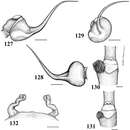Description
provided by Zookeys
Holotype female (IBSP Ref. 74.595). Carapace 21.3 long, 20.0 wide, chelicerae 11.0. Legs (femur, patella, tibia, metatarsus, tarsus, total): I: 17.4, 9.8, 13.1, 11.9, 6.5, 58.7. II: 15.9, 9.1, 11.9, 11.2, 5.9, 54.0. III: 14.0, 8.5, 10.6, 10.7, 5.8, 49.6. IV: 16.5, 9.1, 13.5, 13.9, 5.9, 58.9. Palp: 12.0, 7.0, 8.0, –, 8.1, 35.1. Mid-widths (lateral): femora I–IV = 4.2, 4.2, 4.5, 4.2, palp = 3.3; patellae I–IV = 4.0, 4.3, 3.9, 3.8, palp = 3.4; tibiae I–IV = 3.5, 3.3, 3.1, 3.5, palp=3.0; metatarsi I–IV = 2.6, 2.7, 2.4, 2.4; tarsi I–IV = 2.9, 2.9, 2.9, 2.9, palp = 3.0. Abdomen 22.1 long, 16.9 wide. Spinnerets: PMS, 2.2 long, 1.3 wide, 0.5 apart; PLS, 3.7 basal, 2.5 middle, 3.8 distal; mid-widths (lateral), 2.1, 1.9, 1.4, respectively. Carapace: length to width 1.06. Fovea: deep, 4.4 wide. Eyes: tubercle 1.0 high, 2.5 long, 3.5 wide. Clypeus 1.4. Anterior eye row procurved, posterior slightly recurved. Eye sizes and inter-distances: AME 0.6, ALE 0.7, PME 0.4, PLE 0.7, AME–AME 1.0, AME–ALE 0.5, AME–PME 0.4, ALE–ALE 2.4, ALE–PME 0.9, PME–PME 2.1, PME–PLE 0.2, PLE–PLE 2.7, ALE–PLE 0.5, AME–PLE 0.7. Ratio of eye group width to length 2.1. Maxillae: length to width: 2.2. Cuspules: 100–150 spread over ventral inner heel. Labium: 2.5 long, 3.0 wide, with ca. 100 cuspules spaced by one diameter from each other on the anterior third. Labio-sternal groove deep, narrow, sigilla not evident. Chelicerae: basal segments with ten teeth decreasing in size from distal to basal portion. Sternum: 9.9 long, 7.5 wide. Legs: leg formula: I=IV II III. Scopula: tarsi I–IV fully scopulate. Metatarsi I–II 4/5 scopulate; III 2/3, IV 1/3 distal scopulate. IV divided by five wide row of setae. Urticating hairs type II (0.65 to 0.70 long, 0.02 wide) on abdomen dorsum. Genitalia: paired long and converging spermathecae tapering strongly from base to apex, double folded and with strong constriction forming two (more rarely one or three) distal lobes (Fig. 132). Color pattern: carapace, chelicerae and dorsum of legs and palps covered with short setae having green/blue iridescence and with abundant longer light brown setae giving a brownish appearance. Tarsi dorsally with a “U” orange stripe. Femora ventrally of the same color as the dorsum; patellae, tibiae, metatarsi and tarsi ventrally blackish. Coxae, labium, sternum and maxillae black. Longitudinal stripes on dorsum of femora, patellae, tibiae and metatarsi whitish, conspicuous. Distal femora, patellae, tibiae and metatarsi with white rings. Abdomen dorsum and lateral light-brown with long setae of same color. Central dorsal area blackish, forming a pattern, with long setae having basal part blackish, distal light brown. Urticating hairs reddish. Abdomen ventrally black (Fig. 133).
- bibliographic citation
- Bertani R (2012) Revision, cladistic analysis and biogeography of Typhochlaena C. L. Koch, 1850, Pachistopelma Pocock, 1901 and Iridopelma Pocock, 1901 (Araneae, Theraphosidae, Aviculariinae) ZooKeys 230: 1–94
- author
- Rogério Bertani
Distribution
provided by Zookeys
Brazil, states of Piaui, Maranhão and possibly Tocantins and Pará (Fig. 169). There is a single record for both Tocantins (Colinas de Tocantins) and Pará (Tocantins River). These specimens are smaller than those from Maranhão and Piauí, and the specimen from Pará has both male palpal bulb emboli broken, therefore its identification is only tentative.
- bibliographic citation
- Bertani R (2012) Revision, cladistic analysis and biogeography of Typhochlaena C. L. Koch, 1850, Pachistopelma Pocock, 1901 and Iridopelma Pocock, 1901 (Araneae, Theraphosidae, Aviculariinae) ZooKeys 230: 1–94
- author
- Rogério Bertani

